List of World Heritage Sites in Argentina
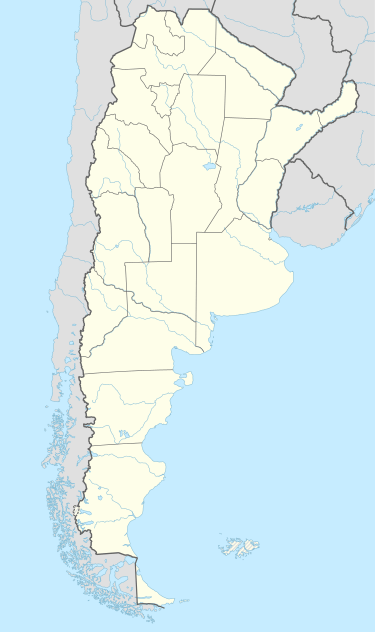
Qhapaq Ñan, Andean Road System
Location of World Heritage Sites within Argentina.
 Cultural category, criteria (i) to (vi)
Cultural category, criteria (i) to (vi) Natural category, criteria (vii) to (x)
Natural category, criteria (vii) to (x)  Intangible Cultural category
Intangible Cultural category
Argentina accepted the UNESCO World Heritage Convention on 23 August 1978.[1] As of 2014, nine properties have been inscribed on the World Heritage List: five cultural sites and four natural sites.[1] A further six sites have been proposed for inscription and are on the tentative list.[1]
World Heritage Sites
These tables list information about inscribed and not yet inscribed (tentative) World Heritage Sites in Argentina:
- Name: as listed by the World Heritage Committee
- Region: of the Provinces of Argentina
- UNESCO data: the site's reference number; the year the site was inscribed on the World Heritage List; the criteria it was listed under: criteria (i) through (vi) are cultural, while (vii) through (x) are natural
- Description: brief description of the site
Inscribed List
Cultural, Natural & Mixed categories
| Name | Image | Region | UNESCO data | Description |
|---|---|---|---|---|
| Los Glaciares National Park | Santa Cruz | 145; 1981; (vii)(viii) | "The Los Glaciares National Park is an area of exceptional natural beauty, with rugged, towering mountains and numerous glacial lakes, including Lake Argentino, which is 160 km (99 mi) long. At its farthest end, three glaciers meet to dump their effluvia into the milky grey glacial water, launching massive igloo icebergs into the lake with thunderous splashes."[2] | |
| Jesuit Missions of the Guaranis: San Ignacio Mini, Santa Ana, Nuestra Señora de Loreto and Santa Maria Mayor | 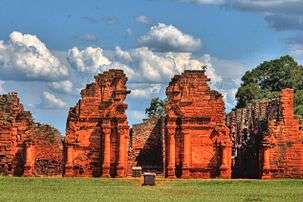 |
Misiones | 275; 1983; (iv) | "The ruins [...] of San Ignacio Miní, Santa Ana, Nuestra Señora de Loreto and Santa María la Mayor in Argentina, lie at the heart of a tropical forest. They are the impressive remains of five Jesuit missions, built in the land of the Guaranis during the 17th and 18th centuries. Each is characterized by a specific layout and a different state of conservation.[3] |
| Iguazú National Park | 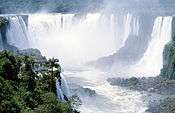 |
Misiones | 303; 1984; (vii)(x) | "The semicircular waterfall at the heart of this site is some 80 m (260 ft) high and 2,700 m (8,900 ft) in diameter and is situated on a basaltic line spanning the border between Argentina and Brazil. Made up of many cascades producing vast sprays of water, it is one of the most spectacular waterfalls in the world. The surrounding subtropical rainforest has over 2,000 species of vascular plants and is home to the typical wildlife of the region: tapirs, giant anteaters, howler monkeys, ocelots, jaguars and caimans."[4] |
| Cueva de las Manos, Río Pinturas | 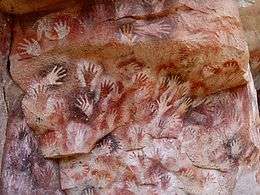 |
Santa Cruz | 936; 1999; (iii) | "The Cueva de las Manos, Río Pinturas, contains an exceptional assemblage of cave art, executed between 13,000 and 9,500 years ago. It takes its name (Cave of the Hands) from the stencilled outlines of human hands in the cave, but there are also many depictions of animals, such as guanacos (Lama guanicoe), still commonly found in the region, as well as hunting scenes. The people responsible for the paintings may have been the ancestors of the historic hunter-gatherer communities of Patagonia found by European settlers in the 19th century."[5] |
| Península Valdés |  |
Chubut | 937; 1999; (x) | "Península Valdés in Patagonia is a site of global significance for the conservation of marine mammals. It is home to an important breeding population of the endangered southern right whale as well as important breeding populations of southern elephant seals and southern sea lions. The orcas in this area have developed a unique hunting strategy to adapt to local coastal conditions."[6] |
| Ischigualasto / Talampaya Natural Parks |  |
966; 2000; (viii) | "These two contiguous parks, extending over 275,300 ha (2,753 km2; 680,000 acres) in the desert region on the western border of the Sierras Pampeanas of central Argentina, contain the most complete continental fossil record known from the Triassic Period (245–208 million years ago). Six geological formations in the parks contain fossils of a wide range of ancestors of mammals, dinosaurs and plants revealing the evolution of vertebrates and the nature of palaeo-environments in the Triassic Period."[7] | |
| Jesuit Block and Estancias of Córdoba | 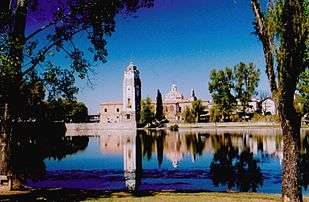 |
Córdoba | 995; 2000; (ii)(iv) | "The Jesuit Block in Córdoba, heart of the former Jesuit Province of Paraguay, contains the core buildings of the Jesuit system: the university, the church and residence of the Society of Jesus, and the college. Along with the five estancias, or farming estates, they contain religious and secular buildings, which illustrate the unique religious, social, and economic experiment carried out in the world for a period of over 150 years in the 17th and 18th centuries."[8] |
| Quebrada de Humahuaca | Jujuy | 1116; 2003; (ii)(iv)(v) | "Quebrada de Humahuaca follows the line of a major cultural route, the Camino Inca, along the spectacular valley of the Rio Grande, from its source in the cold high desert plateau of the High Andean lands to its confluence with the Rio Leone some 150 km (93 mi) to the south. The valley shows substantial evidence of its use as a major trade route over the past 10,000 years. It features visible traces of prehistoric hunter-gatherer communities, of the Inca Empire (15th to 16th centuries) and of the fight for independence in the 19th and 20th centuries."[9] | |
| Qhapaq Ñan, Andean Road System | 1459; 2014; (ii)(iii)(iv)(vi) | "This site is an extensive Inca communication, trade and defence network of roads covering 30,000 km (19,000 mi). Constructed by the Incas over several centuries and partly based on pre-Inca infrastructure, this extraordinary network through one of the world’s most extreme geographical terrains linked the snow-capped peaks of the Andes—at an altitude of more than 6,000 m (20,000 ft)—to the coast, running through hot rainforests, fertile valleys and absolute deserts. It reached its maximum expansion in the 15th century, when it spread across the length and breadth of the Andes. The Qhapac Ñan, Andean Road System includes 273 component sites spread over more than 6,000 km (3,700 mi) that were selected to highlight the social, political, architectural and engineering achievements of the network, along with its associated infrastructure for trade, accommodation and storage, as well as sites of religious significance."[10] | ||
| The Architectural Work of Le Corbusier, an Outstanding Contribution to the Modern Movement |  |
Buenos Aires | 1321-011; 2016; (i)(ii)(vi) | "Chosen from the work of Le Corbusier, the 17 sites comprising this transnational serial property are spread over seven countries and are a testimonial to the invention of a new architectural language that made a break with the past. They were built over a period of a half-century, in the course of what Le Corbusier described as “patient research”. The Complexe du Capitole in Chandigarh (India), the National Museum of Western Art, Tokyo (Japan), the House of Dr Curutchet in La Plata (Argentina) and the Unité d’habitation in Marseille (France) reflect the solutions that the Modern Movement sought to apply during the 20thcentury to the challenges of inventing new architectural techniques to respond to the needs of society. These masterpieces of creative genius also attest to the internationalization of architectural practice across the planet."[11] |
Intangible Cultural category
| Name | Image | Region | UNESCO data | Description |
|---|---|---|---|---|
| Tango |  |
Rio de la Plata Basin | Intangible Heritage listed in 2009 | "The Argentine and Uruguayan tradition of the Tango, now familiar around the world, was developed by the urban lower classes in Buenos Aires and Montevideo in the Rio de la Plata basin. Among this mix of European immigrants to the region, descendents of African slaves and the natives of the region known as criollos, a wide range of customs, beliefs and rituals were merged and transformed into a distinctive cultural identity. As one of the most recognizable embodiments of that identity, the music, dance and poetry of tango both embodies and encourages diversity and cultural dialogue. It is practised in the traditional dance halls of Buenos Aires and Montevideo, spreading the spirit of its community across the globe even as it adapts to new environments and changing times. That community today includes musicians, professional and amateur dancers, choreographers, composers, songwriters, teachers of the art and the national living treasures who embody the culture of tango. Tango is also incorporated into celebrations of national heritage in Argentina and Uruguay, reflecting the widespread embrace of this popular urban music."[12] |
| Filete porteño in Buenos Aires, a traditional painting technique | 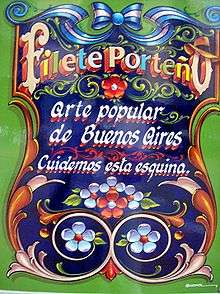 |
Rio de la Plata Basin | Intangible Heritage listed in 2015 | "Filete porteño from Buenos Aires is a traditional painting technique used for ornamental design that combines brilliant colours with specific lettering styles. It can be seen as a form of decoration on urban buses and trucks and is also used for store signage and increasingly, home decoration. Images used relate back to the city’s heritage incorporating social and religious elements, acting as a form of collective memory. Popular designs include icons representing saints, admired politicians, music and sports idols. Sayings and proverbs are sometimes also incorporated in the designs. The technique begins with a drawing, which is then transferred to a support. Synthetic paint, coloured varnish and special longhaired brushes are then used to complete the work. Filete craftsmen transmit this technique to anyone who wants to learn it. Formal education is not required to develop the skills needed, which represents an opportunity for some young people in the community who are at risk of social exclusion. In the last few decades, a new generation of craftswomen have participated in Filete workshops and the practice in general, producing a new aesthetic for the artform."[13] |
Tentative List
The Tentative List consists of sites previously nominated, but not yet inscribed.
| Name | Image | Region | UNESCO data | Description |
|---|---|---|---|---|
| Valle Calchaquí | 1582; Submission: 2001; (ii)(iii)(iv)(v)(vi) | "The Valle Calchaquí forms a 250 km narrow north-south strip along the Calchaquí river, between the structural units of La Puna and the Oriental Mountain Range. A bunch of secondary valleys and gorges, both longitudinal and transversal, build up the tributary system of the Calchaqui river. Las Conchas gorge is, in turn, a deep fluvial valley of 75 km (47 mi) long, that spreads from Alemania town to the joint of Calchaqui and Santa Matia rivers."[14] | ||
| Sierra de las Quijadas National Park | 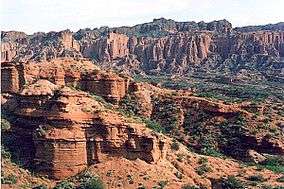 |
San Luis | 2021; Submission: 2005; (vii)(viii)(ix) | "The Sierra de las Quijadas National Park undoubtedly constitutes a "sanctuary" of the flora and fauna of the province of San Luis and of the west-central part of Argentina, since its environment constitutes a transition strip or "ecotone" between the biogeographical provinces of Chaco and Monte. The sedimentary outcrops in Sierra de las Quijadas are part of a chain of geological units the detailed study of which has enabled to complement part of the geohistorical and paleobiological information of the Upper Mesozoic in Argentina, which extends over 120 million years (the entire Jurassic and Cretaceous Periods)."[15] |
| La Payunia, Campos Volcánicos Llancanelo y Payun Matru | Mendoza | 5615; Submission: 2011; (vii)(viii) | "The proposed site includes two protected areas: the Provincial Reserves Llancanelo Lake and Payunia. The first has 90,000 ha (900 km2; 220,000 acres). of protected reserve, of which 65,000 ha (650 km2; 160,000 acres), have been declared a Ramsar site in 1996. It is one of the few areas in the country with a participatory management plan, developed jointly with the residents, and is unique in the world with volumetric limits. The Payunia Reserve covers 192,000 ha (1,920 km2; 470,000 acres) and is reserve since 1982, in the future will be expanded to 450,000 ha (4,500 km2; 1,100,000 acres) using available public land and other private lands with owners arrangement. In this part the volcanic territory reaches its peak focusing in its greater variety of volcanic landforms and creating a stunning landscape."[16] | |
| Parque Nacional Los Alerces (PNLA) | Chubut | 5780; Submission: 2012; (vii)(x) | "Here grow the most aged and well-preserved stands of the Lahuán (Fitzroya cupressoides), a conifer endemic to South America. It is the second longest-living species on Earth after the Californian Sequoia or redwood (Pinus longaeva) with some individuals aged at over 3,600 years (Premoli et al. 2000). Further, it is the largest species in our Valdivian temperate forest and can have a diameter of some 5 m (16 ft) and a height of 50 m (160 ft) (Veblen et al. 1976; Lara 1991; Lara and Villalba 1993)."[17] | |
| Geological, Paleontological and Archaeological Provincial Reserve Pehuén Co–Monte Hermoso | Buenos Aires | 5851; Submission: 2014; (iii)(v)(vi)(viii)(ix) | "In this place, it is preserved, in a section carved by the marine ingression of the Holocene, a geological, paleontological and archeological record of exceptional characteristics. In an extension of about 25 km (16 mi), different sedimentary formations, whose age decreases from West to East, give us detailed information about the history of life and changes in the landscape over the last 5 million years. [...] For this reason, along some kilometers of beaches, which are enlightened with the rising and the setting of the sun of the Atlantic during summer, rocks evoke very different landscapes formed over time and have been inhabited by species living before and after the Great American Biotic Interchange (GABI)."[18] |
See also
References
- 1 2 3 "Argentina". Paris: UNESCO – United Nations Educational, Scientific and Cultural Organization. 2014.
- ↑ "Los Glaciares National Park". Paris: UNESCO – United Nations Educational, Scientific and Cultural Organization. 2014.
- ↑ "Jesuit Missions of the Guaranis: San Ignacio Mini, Santa Ana, Nuestra Señora de Loreto and Santa Maria Mayor (Argentina), Ruins of Sao Miguel das Missoes (Brazil)". Paris: UNESCO – United Nations Educational, Scientific and Cultural Organization. 2014.
- ↑ "Iguazu National Park". Paris: UNESCO – United Nations Educational, Scientific and Cultural Organization. 2014.
- ↑ "Cueva de las Manos, Río Pinturas". Paris: UNESCO – United Nations Educational, Scientific and Cultural Organization. 2014.
- ↑ "Península Valdés". Paris: UNESCO – United Nations Educational, Scientific and Cultural Organization. 2014.
- ↑ "Ischigualasto / Talampaya Natural Parks". Paris: UNESCO – United Nations Educational, Scientific and Cultural Organization. 2014.
- ↑ "Jesuit Block and Estancias of Córdoba". Paris: UNESCO – United Nations Educational, Scientific and Cultural Organization. 2014.
- ↑ "Quebrada de Humahuaca". Paris: UNESCO – United Nations Educational, Scientific and Cultural Organization. 2014.
- ↑ "Qhapaq Ñan, Andean Road System". Paris: UNESCO – United Nations Educational, Scientific and Cultural Organization. 2014.
- ↑ "The Architectural Work of Le Corbusier, an Outstanding Contribution to the Modern Movement". Paris: UNESCO – United Nations Educational, Scientific and Cultural Organization. 2016.
- ↑ "Tango". Paris: UNESCO – United Nations Educational, Scientific and Cultural Organization. 2014.
- ↑ "Filete porteño in Buenos Aires, a traditional painting technique". Paris: UNESCO – United Nations Educational, Scientific and Cultural Organization. 2015.
- ↑ "Valle Calchaquí". Paris: UNESCO – United Nations Educational, Scientific and Cultural Organization. 2014.
- ↑ "Sierra de las Quijadas National Park". Paris: UNESCO – United Nations Educational, Scientific and Cultural Organization. 2014.
- ↑ "La Payunia, Campos Volcánicos Llancanelo y Payún Matrú". Paris: UNESCO – United Nations Educational, Scientific and Cultural Organization. 2014.
- ↑ "Parque Nacional Los Alerces (PNLA)". Paris: UNESCO – United Nations Educational, Scientific and Cultural Organization. 2014.
- ↑ "Geological, Paleontological and Archaeological Provincial Reserve Pehuén Co – Monte Hermoso". Paris: UNESCO – United Nations Educational, Scientific and Cultural Organization. 2014.
External links
| Wikimedia Commons has media related to World Heritage Sites in Argentina. |
- Argentina at UNESCO World Heritage Convention
This article is issued from Wikipedia - version of the 10/14/2016. The text is available under the Creative Commons Attribution/Share Alike but additional terms may apply for the media files.
